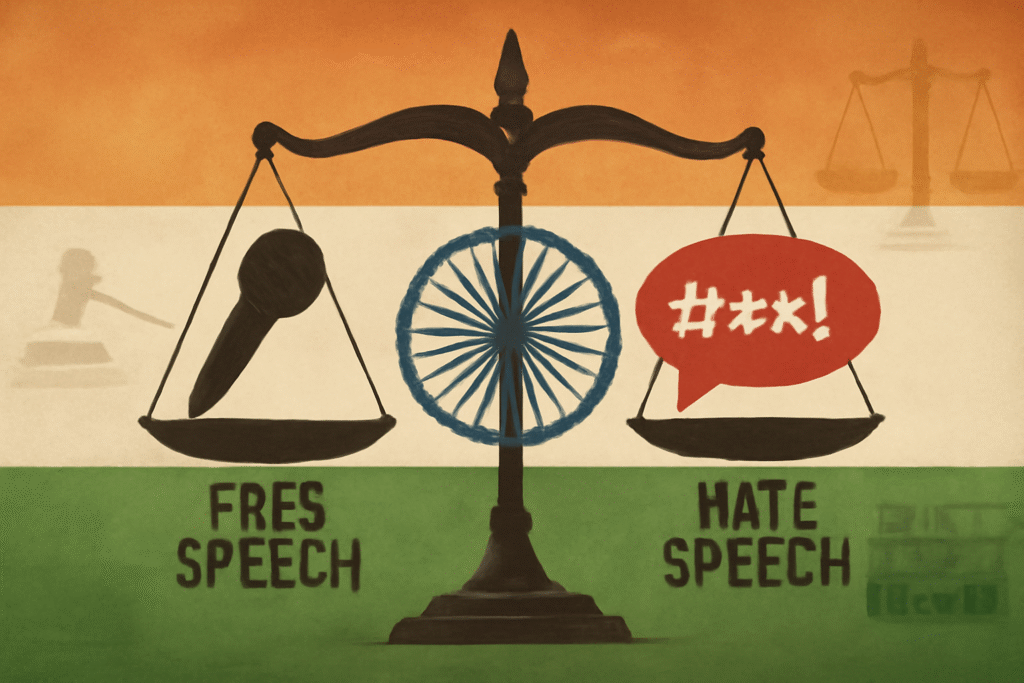Published On: 14th October, 2024
Authored By: Devanshi Sharma
Himachal Pradesh National Law University, Shimla
“Our planet’s biodiversity is not a luxury but a necessity. Protecting wildlife is not merely preserving species, but safeguarding the intricate web of life that sustains us all.”
ABSTRACT: This article delves into the evolution of wildlife protection laws in India, tracing their roots from ancient reverence to modern legislation. It examines the critical role of wildlife in ecological balance and human well-being, highlighting the challenges faced in enforcement and the transformative potential of technology. The study emphasises the need for a comprehensive approach combining robust legal frameworks, technological advancements, and public engagement to safeguard India’s rich biodiversity.
KEYWORDS: Wildlife Protection Laws (WPL), Conservation of Resources, Technology, Evolution of WPL, Challenges under WPL.
INTRODUCTION
Wildlife plays a crucial role in maintaining the balance of ecosystems and ensuring the health of our planet. Every species contributes to ecological stability, from the largest mammals to the smallest insects. Predators control the populations of prey animals, preventing overgrazing and promoting plant diversity. Herbivores affect plant communities and influence the structure of habitats. Pollinators, such as bees and butterflies, are vital for reproducing many plants, including crops essential for human consumption.[1]
Moreover, wildlife enriches human life through cultural, recreational, and scientific values. Many cultures revere animals as symbols of spiritual significance, while activities like bird-watching and safaris offer economic benefits and promote conservation awareness. Scientific research on wildlife helps us understand disease, behaviour, and genetics, leading to advancements in medicine and technology.[2]
Protecting wildlife is imperative as human activities, like deforestation and climate change, threaten their habitats. Conservation efforts ensure the survival of species and the overall health of ecosystems. By preserving wildlife, we safeguard biodiversity, support ecological functions, and maintain the natural beauty that enhances our world. In essence, wildlife is integral to the environment, our well-being and our cultural heritage. Society has increasingly recognised the importance of wildlife in sustaining ecological balance and enriching human life. Despite this growing awareness, a segment of the population remains unaware of or indifferent to the significance of wildlife conservation. To address this issue, governments and organisations have implemented various rules, acts, and regulations designed to protect wildlife and their habitats.[3] These legal frameworks aim to mitigate the impacts of human activities, enforce conservation measures, and educate the public about the necessity of preserving biodiversity. [4]By establishing and upholding these regulations, society can foster a deeper understanding of wildlife issues and ensure that future generations inherit a healthier and more diverse natural world.[5]
EVOLUTION OF WILDLIFE PROTECTION LAW
In the Wildlife Protection Act of 1972[6], the term “wildlife” is defined in Section 2(37)[7] As it encompasses any animal, aquatic or terrestrial vegetation within any natural habitat, it becomes essential to understand how wildlife protection laws evolved throughout the period. India’s profound reverence for nature and wildlife is deeply ingrained in its cultural and historical fabric. This ethos, dating back millennia, has shaped the nation’s approach to environmental stewardship. The evolution of the Wildlife Protection Acts can be studied in 3 different eras, which are pre-colonial, colonial and post-colonial.
From the Vedic period onwards, a spiritual connection with nature was fostered. The Vedas extolled the environment, and the epics like Ramayana and Mahabharata highlighted the integral role of animals in society.[8] This reverence was further exemplified by subsequent Hindu and Muslim rulers, including the Mauryas, Guptas, and Mughals, who recognised the intrinsic value of preserving biodiversity despite lacking formal wildlife laws.
Ancient Indian wisdom, as encapsulated in the Vedas and the teachings of the Rishis, emphasised the interconnectedness of humans and nature. The practice of totemism among tribal communities where clans were associated with specific plants or animals underscores this deep-rooted bond. Moreover, the Manu Smriti, an early legal code, established environmental protection as a duty, with penalties for harm to the ecosystem.[9]
Ashoka, the Great, stands out as a pioneering conservationist. His reign witnessed the world’s first documented wildlife conservation law. The edict prohibited killing numerous bird and mammal species, marking a significant step towards the ethical treatment of animals. This commitment to wildlife welfare was rooted in a broader philosophy of compassion and respect for all living beings.
Even during the Mughal era, emperors exhibited a contrasting appreciation for nature. Their chronicles and the accounts of foreign travellers reveal a keen interest in wildlife and efforts to conserve it. Pre-colonial India’s legacy of wildlife conservation is a testament to the nation’s enduring respect for nature.[10] This historical foundation laid the groundwork for modern conservation initiatives and continues to inspire efforts to protect India’s rich biodiversity.
Under British rule, the trajectory of wildlife conservation in India is a complex interplay of conflicting priorities, evolving attitudes and institutional developments.
In the 19th century, we witnessed a gradual shift in perspective. As the ecological implications of rampant deforestation and hunting became apparent, a nascent conservation movement emerged. This growing awareness and the aesthetic appeal of India’s wildlife for European visitors spurred interest in preservation.[11] It is crucial to note that conservation was often intertwined with the colonial hunting culture. The establishment of protected areas was partly motivated by the desire to sustain game populations for hunting.
The Indian Forest Act of 1878 marked a significant step towards formalising forest management, though its primary purpose was revenue generation rather than ecological protection. Subsequent legislation, such as the Wild Birds Protection Act of 1887 and the Wild Bird and Animals Protection Act of 1912, indicated a growing recognition of the need to safeguard specific species.
Nevertheless, the legal framework remained inadequate to address the broader challenges of environmental degradation. Laws governing fisheries, pollution, and other environmental issues were fragmented and insufficient to prevent the exploitation of natural resources. The absence of a comprehensive approach to conservation limited the impact of these early efforts.[12]
A pivotal moment in India’s conservation history was the establishment of Corbett National Park in 1935.[13] Jim Corbett’s vision and the colonial administration’s support were instrumental in creating this protected area.[14]
A conflicted relationship with wildlife characterised the British period in India. Destructive practices marked the early years of a growing awareness of wildlife’s ecology and aesthetics.[15] However, colonial priorities often constrained conservation efforts and the legal and institutional framework remained underdeveloped. The legacy of this period is complex, with both positive and negative impacts on India’s natural heritage.[16]
Despite growing awareness of the ecological imperative, shifting public attitudes towards wildlife posed significant challenges to India’s conservation efforts. A culture deeply entrenched in hunting hindered progress, particularly among the elite. While the government introduced measures to curb poaching and illegal wildlife trade, the lucrative nature of this illicit business perpetuated the crisis.[17] The advent of modern technology exacerbated the problem, enabling more efficient hunting and contributing to habitat destruction.
A turning point arrived in the latter half of the 20th century, marked by a paradigm shift in policy. The Wildlife Protection Act of 1972 and the subsequent launch of Project Tiger signified India’s unwavering commitment to safeguarding its natural heritage. These initiatives laid the foundation for a more proactive approach to conservation.
WILDLIFE PROTECTION ACTS AND ITS KEY PROVISIONS
The Wildlife Protection Act of 1972 is the primary legislation governing the protection of wild animals and birds in post-independence India. This act was introduced in response to the urgent need for robust and centralised legislation due to the rapid decline in wildlife and the destruction of natural habitats. While the Indian Constitution initially placed “wild animals and birds” under the “State List” in Schedule VII, granting legislative power to individual states, the severity of the wildlife crisis led several states—including Andhra Pradesh, Bihar, Gujarat, Haryana, Himachal Pradesh, Madhya Pradesh, Manipur, Punjab, Rajasthan, Uttar Pradesh, and West Bengal—to pass resolutions under Article 252. This allowed Parliament to create a comprehensive national law for wildlife conservation.[18]
Recognising that existing state laws were insufficient, the central government sought to establish a unified legal framework. The Wildlife Protection Act of 1972 and its amendments up to 2006 address protecting and conserving wildlife nationwide. The alarming and ongoing decline of wildlife in India, with some species already extinct and others at risk, has underscored the importance of this legislation.[19]
Under the Wildlife Protection Act of 1972, several vital bodies are established to manage and oversee wildlife conservation in India. The National Board for Wildlife (NBWL) acts as the apex body, reviewing all wildlife-related matters and approving projects within and around national parks and sanctuaries.[20] The State Board for Wildlife (SBWL), chaired by the Chief Minister of each state or Union Territory (UT), addresses state-specific wildlife protection issues. [21]The Central Zoo Authority (CZA), comprising ten members including a Chairperson and a Member-Secretary, regulates zoos nationwide, ensuring they adhere to guidelines and rules for animal welfare and transfers. The National Tiger Conservation Authority (NTCA), created in 2005 following the Tiger Task Force’s recommendations, focuses on strengthening tiger conservation, with the Union Environment Minister as Chairperson and the State Environment Minister as Vice-Chairperson, and plays a role in declaring Tiger Reserves. Lastly, the Wildlife Crime Control Bureau (WCCB) was established to tackle organised wildlife crime, including illegal trade and poaching, through coordinated enforcement efforts and intelligence gathering.
ENFORCEMENT CHALLENGES AND SOLUTIONS
Despite its long-standing existence, the Wildlife Protection Act (WPA) of 1972 faces several significant challenges that hinder its effectiveness in protecting wildlife. One major issue is the lack of awareness. Many people are still not fully informed about the importance of wildlife conservation and the legal provisions under the WPA. Another critical challenge is human-wildlife conflict, which has intensified due to increased human encroachment on wildlife habitats, often resulting in illegal wildlife killings.[22] Illegal wildlife trade also poses a severe threat, with poaching and trafficking continuing to thrive despite stringent regulations. Coordination among governmental agencies—such as the forest department, police, customs, and revenue departments—often falls short, complicating efforts to enforce the WPA and curb illegal activities. Penalties for wildlife crimes under the WPA are frequently inadequate, with fines and sentences that fail to deter offenders effectively.[23] Community participation is also lacking, as local involvement is crucial for the success of conservation initiatives but is often minimal. Finally, climate change represents an emerging threat, affecting wildlife habitats and exacerbating existing challenges, necessitating a more adaptive and comprehensive approach within the WPA to address these evolving environmental impacts.[24]
ROLE OF TECHNOLOGY IN WILDLIFE CONSERVATION
Technology has become a cornerstone in advancing wildlife conservation, offering innovative tools and methods to enhance monitoring, data collection, and protection efforts. Remote sensing technology, including satellite imagery and drones, provides comprehensive data on wildlife habitats and environmental changes.[25] Satellites can capture large-scale land cover changes, track deforestation, and monitor climate effects on ecosystems. Drones equipped with high-resolution cameras offer detailed views of landscapes and can monitor inaccessible areas[26]. These tools are instrumental in tracking animal migrations, habitat fragmentation, and the impacts of human activities on wildlife.
- Camera Traps and Motion Sensors: Camera traps are strategically placed in natural habitats to capture images and videos of wildlife without human interference. These devices are triggered by motion sensors, allowing researchers to document animal behaviour, identify species, and estimate population sizes. Camera traps are handy in studying elusive or nocturnal species and gathering data on predator-prey dynamics and habitat use.[27]
- GPS and Radio Tracking: GPS collars and radio transmitters attached to animals provide real-time location data, enabling researchers to track individual movements and behaviours over time. This technology helps understand migration routes, territory sizes, and interactions among species. By monitoring these movements, conservationists can identify critical habitats, assess the impacts of human activities, and implement targeted protection measures.[28]
- Genetic Analysis: Advances in genetic technologies, such as DNA sequencing and molecular markers, offer insights into wildlife populations’ genetic diversity and health. Genetic analysis helps identify species, assess genetic variation, and study population structure.[29] It also plays a crucial role in combating illegal wildlife trade by tracing the origins of wildlife products and ensuring that conservation efforts are based on accurate species identification.[30]
- Data Management Systems: Modern data management platforms and databases facilitate collecting, storing, and analysing large volumes of ecological and conservation data.[31] These systems enable researchers to integrate diverse datasets, track conservation outcomes, and make data-driven decisions.[32] Advanced analytics tools help visualise trends, evaluate conservation strategies’ effectiveness, and share information with stakeholders.[33]
- Artificial Intelligence (AI) and Machine Learning: AI and machine learning algorithms analyse complex datasets, such as camera traps or satellite imagery images.[34] These technologies can automatically identify and classify species, detect unusual patterns or behaviours and predict potential threats to wildlife.[35] AI-driven tools improve the accuracy and efficiency of data analysis, allowing for more timely and informed conservation actions.[36]
- Public Engagement and Awareness: Digital platforms, including social media, websites, and mobile apps, play a significant role in raising awareness and engaging the public in wildlife conservation. Interactive tools such as virtual reality (VR) experiences and online mapping applications provide immersive ways to educate people about wildlife and their habitats. These platforms help mobilise public support, promote conservation initiatives, and foster a sense of connection with nature.
- Conservation Drones: Drones equipped with cameras and sensors are used for various conservation tasks, including aerial surveys of wildlife populations, monitoring habitat conditions, and detecting illegal activities such as poaching or logging. Drones provide a bird’s-eye view that enhances the ability to assess and respond to environmental changes and threats, particularly in remote or difficult-to-access areas.[37]
- Anti-Poaching Technologies: Many anti-poaching technologies, including electronic surveillance systems, intelligent collars with GPS and alarm features, and anti-poaching drones, prevent and combat illegal hunting. These technologies help monitor protected areas, detect poaching incidents in real time, and alert authorities to take immediate action. By enhancing surveillance and response capabilities, these tools contribute to protecting endangered species and their habitats.[38]
CONCLUSION
The Wildlife Protection Act of 1972 represents a pivotal step in India’s commitment to conserving its rich biodiversity. Despite its significant achievements, the Act faces several enforcement challenges, including inadequate public awareness, escalating human-wildlife conflicts and the ongoing threats of illegal wildlife trade and climate change. Addressing these challenges requires a robust legal framework and effective coordination among various governmental and non-governmental bodies.
Integrating advanced technologies—such as satellite tracking, camera traps, genetic analysis, and artificial intelligence—has revolutionised wildlife conservation efforts, enabling more precise monitoring and enhanced protection strategies. These technological advancements provide critical tools for understanding and mitigating the complex threats faced by wildlife, from habitat loss to poaching.[39]
Ultimately, the success of wildlife conservation hinges on a multifaceted approach that combines stringent legal measures, innovative technology, and active community engagement. By fostering a deeper public understanding of the intrinsic value of wildlife and leveraging technological advancements, we can better safeguard the intricate web of life that sustains our planet and ensure a healthier, more diverse natural world for future generations.
References
[1] Wildlife Protection Act available at https://haryanaforest.gov.in/wild-life-protection-act/ (last visited 4 August 2024).
[2] Juanita Gomez, Nella Canales, Nathalie Van Vliet, The Values of Wildlife Revisited available at https://ecologyandsociety.org/vol27/iss4/art23/ (last visited 4 August 2024).
[3] Supra note 2 at page 1.
[4] ibid.
[5] Elisa Morgera, James Wingard, Principles for Developing Sustainable Wildlife Management Laws available at https://www.fao.org/fileadmin/user_upload/legal/docs/lpo75.pdf (last visited 4 August 2024).
[6] Wildlife Protect Act 1972.
[7] ibid.
[8] Atul Sathe, India Epics and Environment Conservation available at https://mitvedicsciences.edu.in/archives/5533 (last visited 4 August 2024).
[9] Sachidananda Padhy, Santosh K. Dash and Ratna Prava Mohapatra, Environmental Laws of Manu: A concise Review available at http://krepublishers.com/02-Journals/JHE/JHE-19-0-000-000-2006-Web/JHE-19-1-000-000-2006-Abstract-PDF/JHE-19-1-001-012-2006-1414-Padhy-S-N/JHE-19-1-001-012-2006-1414-Padhy-S-N-Text.pdf (last visited 4 August 2024).
[10] Siddharth Rajak, Prof. Kalpana Chaturvedi, Impact of Historical Policies and Laws On Forest and Wildlife Conservation in India, available at https://www.ijnrd.org/papers/IJNRD2309403.pdf (last visited 4 August 2024).
[11] ibid.
[12] Vijaya Ramadas Mandala, The Raj and the Paradoxes of Wildlife Conservation: British Attitudes and Expediencies available at https://academic.oup.com/book/25521/chapter-abstract/192784947?redirectedFrom=fulltext (last visited 4 August 2024).
[13] Jim Corbett National Park – History available at https://jimcorbett.in/corbett-history (last visited 4 August 2024).
[14] ibid.
[15] Supra note 12.
[16] Supra note 15 at page 3.
[17] Stephen F Pieres, William Moretto, The Illegal Wildlife Trade available at https://www.researchgate.net/publication/304998952_The_Illegal_Wildlife_Trade (last visited 4 August 2024).
[18] ibid.
[19] The National Wildlife Action Plan available at https://forest.and.nic.in/ActsNRules%5CNational%20Wild%20life%20Action%20Plan%20-%202002.pdf (last visited 4 August 2024).
[20] ibid.
[21] ibid.
[22] Deepika Prakash Alizad, A Critical Study on Wildlife (Protection) Act, 1972 available at https://ijarsct.co.in/Paper16683.pdf (last visited 4 August 2024).
[23] ibid.
[24] Harmony in Conservation: The Vital Role of Community-Led Conservation in Our Mission available at https://www.ecolifeconservation.org/updates/the-vital-role-of-community-led-conservation/ (last visited 4 August 2024).
[25] Remote Sensing and Artificial Intelligence for Wildlife Conservation available at https://www.satimagingcorp.com/applications/environmental-impact-studies/wildlife-and-marine-conservation/wildlife-conservation/ (last visited 5 August 2024).
[26] Serge Wich, Lian Pin Koh, Conservation drones: Mapping and monitoring biodiversity available at https://www.researchgate.net/publication/330080112_Conservation_drones_Mapping_and_monitoring_biodiversity (last visited 5 August 2024).
[27] ibid.
[28] Stanley M. Tomkiewicz, Mark R. Fuller, John G. Kie, Kirk K. Bates, Global positioning system and associated technologies in animal behaviour and ecological research available at https://www.ncbi.nlm.nih.gov/pmc/articles/PMC2894966/ (last visited 5 August 2024).
[29] Kanika Ghildiyal, Sonali Sonejita Nayak, Divya Rajawat, Anurodh Sharma, Supriya Chhotaray, Bharat Bhushan, Triveni Dutt, Manjit Panigrahi, Genomic insights into the conservation of wild and domestic animal diversity: A review available at https://www.sciencedirect.com/science/article/abs/pii/S0378111923005607 (last visited 5 August 2024).
[30] ibid.
[31] Kinza Yasar, Database Management System available at https://www.techtarget.com/searchdatamanagement/definition/database-management-system (last visited 5 August 2024).
[32] ibid.
[33] ibid.
[34] Supra note 33 at page 6.
[35]Li Zhang, Wenqiang Guo, Chenrui Lv, Meng Guo, Mei Yang, Qiuyue Fu, Xiaomeng Liu, Advancements in artificial intelligence technology for improving animal welfare: Current applications and research progress available at https://onlinelibrary.wiley.com/doi/full/10.1002/aro2.44 (last visited 5 August 2024).
[36] ibid.
[37] Supra note 26 at page 6.
[38] Jacob Kamminga, Eyuel Ayele, Nirvana Meratnia, Paul Havinga, Poaching Detection Technologies—A Survey available at https://www.ncbi.nlm.nih.gov/pmc/articles/PMC5982520/ (last visited 5 August 2024).
[39] World Wildlife Crime Report available at https://www.unodc.org/documents/data-and-analysis/wildlife/2020/World_Wildlife_Report_2020_9July.pdf (last visited 5 August 2024).




